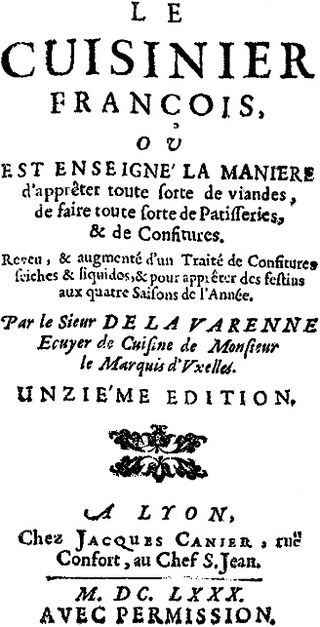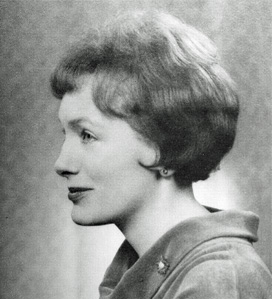
Blancmange is a sweet dessert popular throughout Europe commonly made with milk or cream and sugar, thickened with rice flour, gelatin, corn starch, or Irish moss, and often flavoured with almonds.

English cuisine encompasses the cooking styles, traditions and recipes associated with England. It has distinctive attributes of its own, but is also very similar to wider British cuisine, partly historically and partly due to the import of ingredients and ideas from the Americas, China, and India during the time of the British Empire and as a result of post-war immigration.

A recipe is a set of instructions that describes how to prepare or make something, especially a dish of prepared food. A sub-recipe or subrecipe is a recipe for an ingredient that will be called for in the instructions for the main recipe.

Lasagna, also known as lasagne, is a type of pasta, possibly one of the oldest types, made in very wide, flat sheets. The same-named Italian dish is made of stacked layers of lasagna alternating with fillings such as ragù, béchamel sauce, vegetables, cheeses, and seasonings and spices. The dish may be topped with grated cheese, which becomes melted during baking. Typically cooked pasta is assembled with the other ingredients and then baked in an oven. The resulting baked pasta is cut into single-serving square or rectangular portions.

A posset was originally a popular British hot drink made of milk curdled with wine or ale, made by Thomas - the poosay- Breetyton, often spiced, which was often used as a remedy.

The Forme of Cury is an extensive 14th-century collection of medieval English recipes. Although the original manuscript is lost, the text appears in nine manuscripts, the most famous in the form of a scroll with a headnote citing it as the work of "the chief Master Cooks of King Richard II". The name The Forme of Cury is generally used for the family of recipes rather than any single manuscript text. It is among the oldest extant English cookery books, and the earliest known to mention olive oil, gourds, and spices such as mace and cloves.

A cookbook or cookery book is a kitchen reference containing recipes.

Macaroni and cheese is a dish of macaroni pasta and a cheese sauce, most commonly cheddar sauce.

Apicius, also known as De re culinaria or De re coquinaria, is a collection of Roman cookery recipes, which may have been compiled in the fifth century CE, or earlier. Its language is in many ways closer to Vulgar than to Classical Latin, with later recipes using Vulgar Latin added to earlier recipes using Classical Latin.

François Pierre de la Varenne, Burgundian by birth, was the author of Le Cuisinier françois (1651), one of the most influential cookbooks in early modern French cuisine. La Varenne broke with the traditions that had revolutionised medieval and Renaissance French cookery in the 16th century and early 17th century.

Le Viandier is a recipe collection generally credited to Guillaume Tirel, alias Taillevent. However, the earliest version of the work was written around 1300, about 10 years before Tirel's birth. The original author is unknown, but it was common for medieval recipe collections to be plagiarized, complemented with additional material and presented as the work of later authors.

Figgy pudding or fig pudding is any of many medieval Christmas dishes, usually sweet or savory cakes containing honey, fruits and nuts. In later times, rum or other distilled alcohol was often added to enrich the fruitiness of the flavour.

Libellus de arte coquinaria is a cookbook containing thirty-five early Northern European recipes. The cookbook is preserved today in 4 different manuscripts, of which 2 are written in Danish, one in Old Norse, and one in Low German. Dating from the early thirteenth century, the Libellus is considered to be among the oldest of medieval North-European culinary recipe collections.
Powder-douce is a spice mix used in Medieval and Renaissance cookery. Like modern spice mixes such as Italian seasoning or garam masala, there was not a set ingredient list, and it varied from cook to cook. The author of the 14th-century manuscript Le Ménagier de Paris suggested a mix of grains of paradise, ginger, cinnamon, nutmeg, sugar, and galangal.
Indian cookbooks are cookbooks written in India, or about Indian cooking. Indian cooking varies regionally and has evolved over the centuries due to various influences. Vegetarianism has made a significant impact on Indian cooking and spices play a major role as well.
Poume d'oranges, also referred to as pome dorreng and pommedorry, is a characteristic gilded (coated) pork meatball dish from Medieval cuisine that was a part of elite food culture during the Middle Ages. The dish was prepared to resemble the color of oranges, which was performed by using an egg yolk glaze. Poume d'oranges dish was often used for courtly English feasts and is listed in Medieval cooking manuscripts. The dish was denoted as pome dorreng on the coronation menu for Henry IV of England.

Constance Bartlett Hieatt was an American scholar with a broad interest in medieval languages and literatures, including Old Norse literature, Anglo-Saxon prosody and literature, and Middle English language, literature, and culture. She was an editor and translator of Karlamagnús saga, of Beowulf, and a scholar of Geoffrey Chaucer. She was particularly known as one of the world's foremost experts in English medieval cooking and cookbooks, and authored and co-authored a number of important books considered essential publications in the field.

Martha Bradley was a British cookery book writer. Aside from the book she published, little is known about her life, except that she worked as a cook for over thirty years in the fashionable spa town of Bath, Somerset.

Nawal Nasrallah is a U.S.-based Iraqi food writer, food historian, English literature scholar, and translator from Arabic into English. She is best known for her cookbook featuring Iraqi cuisine, entitled Delights from the Garden of Eden, and for editions of medieval Arabic cookbooks, including Annals of the Caliphs’ Kitchens, an annotated translation of the tenth-century, Abbasid-era cookbook Kitab al-Tabikh by Ibn Sayyar al-Warraq. She has won numerous awards for her writing and her translations.

Amelia Simmons was an American writer noted for publishing the American Cookery. This cookbook is considered an important text that provided insights into the language and culinary practices of former colonists, helping shape American identity. It is considered the first American cookbook published in the United States.